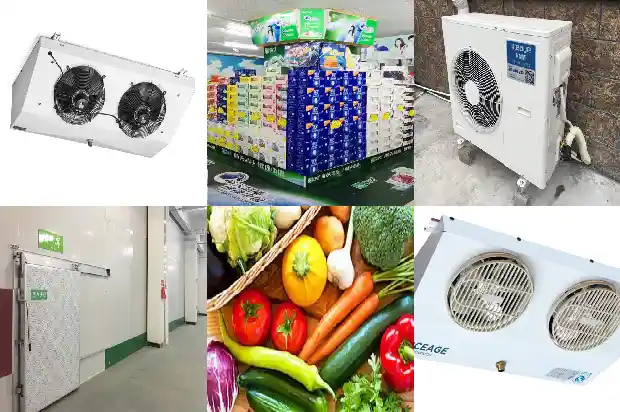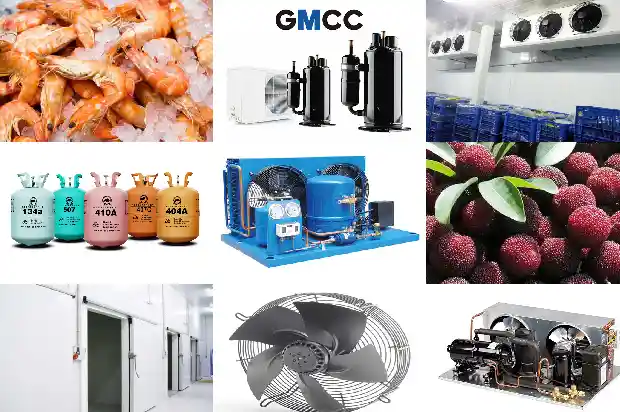What Are the Differences Between R22 and R404A Cold Storage Systems?
2025-02-14
Previously, many cold storages used R22 refrigerant. Nowadays, the use of R404A refrigerant is on the rise. So, why do cold storages opt for R404A refrigerant, which is relatively more costly? What are the differences between R22 and R404A cold - storage systems?
Firstly, R22 refrigerant is non - environmentally friendly and has been phased out in developed countries in Europe and America. Although R404A has a high Global Warming Potential (GWP) value and isn't a truly eco - friendly refrigerant, it is still more environmentally friendly compared to R22.

Differences between R22 and R404A Cold - Storage Systems
- The R404A cold - storage system and its lubricating oil have excellent solubility with water. Consequently, compared to the R22 cold - storage system, requirements for moisture, residues, and cleanliness in the system have increased. Moisture and impurity control in the R404A system are crucial indicators, and the corresponding filtration devices in the system need to be modified.
- The discharge pressure of the R404A cold - storage system is approximately 1.2 times that of R22, and the mass flow rate is around 1.5 times that of R22. The increased discharge flow velocity leads to greater resistance. Generally, the heat - exchange capacity of the condenser should be 20% - 30% larger than that of R22.
- The saturated pressures of the R404A cold - storage system and R22 differ at the same temperature.
Thus, the operating mechanism of the thermostatic expansion valve for R404A is distinct from that of R22. Moreover, due to the different compatibility of the R404A refrigerant and lubricating oil with the sealing materials, the sealing materials of the expansion valve must also be changed accordingly. Therefore, a dedicated expansion valve for R404A should be selected for the thermostatic expansion valve.
- Since the saturated pressure of the R404A cold - storage system is higher than that of R22, the pressure - bearing capacity of pressure vessels in the system, such as the liquid receiver and gas - liquid separator, must also be higher. Simultaneously, the set values of safety valves and fusible plugs installed on system accessories need to be adjusted accordingly. Under the condition of the same displacement, the gas density of R404A is approximately 50% greater than that of R22. Thus, when designing the piping for the R404A cold - storage system, a larger pipe diameter should be chosen compared to R22.
- For the same compressor, the current in the R404A cold - storage system is higher than that in the R22 system. As a result, the specifications of the AC contactor, thermal relay, and the wire diameter of the compressor's cable need to be adjusted. In terms of system protection, the set value of the high - pressure switch is adjusted from the original 2.45MPa to 2.7MPa.
- Because the saturated pressure of the 404A cold - storage system differs from that of R22, the air - tightness test pressure should be higher than that of R22. Meanwhile, the system's vacuum degree should be higher, and the water content should be lower than that of R22. When charging the refrigerant, it should be done in a liquid state to prevent changes in the composition of R404A.
- R404A is a zeotropic mixture refrigerant. The composition concentration of a zeotropic mixture varies with temperature and pressure. This poses certain challenges to the production, commissioning, and maintenance of the refrigeration system and also affects the system's heat - transfer performance. Especially when the refrigerant leaks, all the refrigerant in the system needs to be emptied and replaced to ensure the proportion of each mixed component and achieve the designed refrigeration effect. Otherwise, the situation will deteriorate.
- The lubricating oil for the R404A cold - storage system is different from that for R22. PVE ester - based oil must be used to replace the mineral lubricating oil used in R22. Ester - based lubricating oil has a high affinity for water and poor dewatering properties. Therefore, during use, it should be avoided coming into contact with outside air as much as possible. After opening the container, it should be used promptly and stored in a sealed manner after use. Keep it away from oxidants, strong alkalis, and strong acids, and store it in a well - ventilated area. When using it, avoid contact with skin and eyes, and do not inhale its vapor or spray.
Related Articles
- What Are the Differences Between Chillers and General Water - cooled Equipment?
- Characteristics and Differences among Water System, Air System and Refrigerant System
- What Are the Differences Between Cold Storage and Freezer?
- Differences Between Steel Structure Cold Storages and Multi-story Civil Engineering Cold Storages
- Temperature Gradient Differences between Deep Foundation and Surface of Civil Cold Storage
- Differences, Requirements and Standards between Pharmaceutical Cold Storage and Conventional Cold Storage
- What Are the Common Reasons for Difficulties in Cooling a Cold Storage?
- Introduction to Inspection and Handling Methods for Refrigerant Leak in Cold Storage
- How to Resolve the Scuffing Issue of Cold Storage Compressors
- What is the Correct Operation Method of the Distribution Box during Cold Storage Installation?
- Reasons for Frost Formation in Cold Storage and Defrosting Methods
- Maintenance Methods for Small Modular Cold Storage Failures
- What Vacuum Requirements Do Cold Storage Equipment Have?
- What Issues Should Be Noted in Cold Storage Installation and Construction?
- Common Malfunctions in the Operation of Cold Storage
- What Special Requirements are There for the Installation of Tea Cold Storage?
- How to Solve the Problem of Frequent Shutdown and Startup of Cold Storage Compressors?
- What are the Storage Conditions of Nectarine in Controlled Atmosphere Cold Storage?
